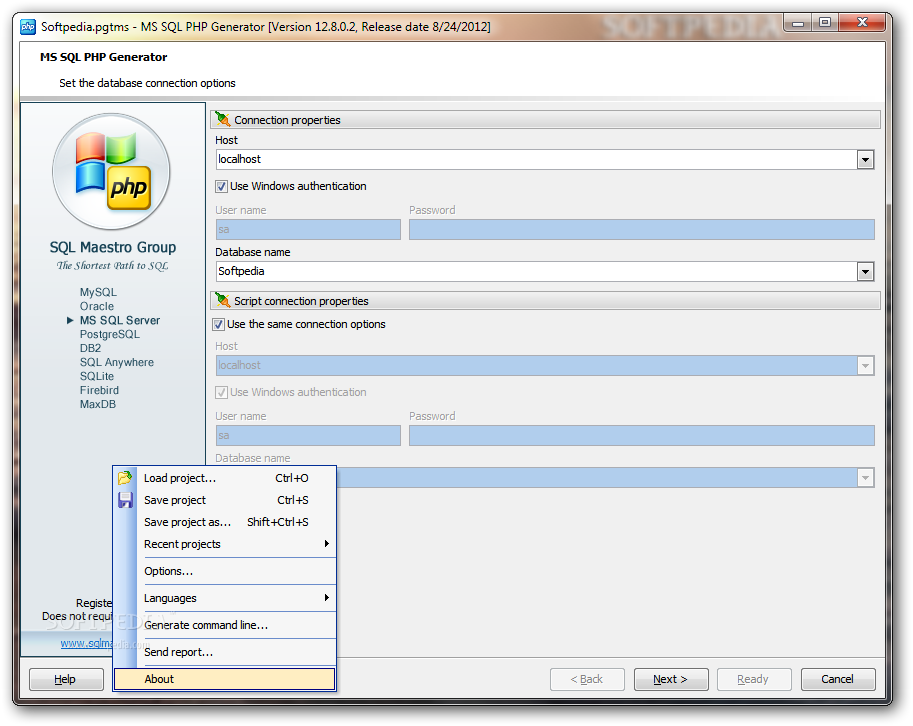

- #Php generator for mysql prohects how to
- #Php generator for mysql prohects software
- #Php generator for mysql prohects code
- #Php generator for mysql prohects license
Over time, PHP interpreters became available on most existing 32-bit and 64-bit operating systems, either by building them from the PHP source code, or by using pre-built binaries.

#Php generator for mysql prohects code
Many high-profile open-source projects ceased to support PHP 4 in new code from February 5, 2008, because of the GoPHP5 initiative, provided by a consortium of PHP developers promoting the transition from PHP 4 to PHP 5. Late static binding had been missing from previous versions of PHP, and was added in version 5.3. In 2008, PHP 5 became the only stable version under development. PHP 5 included new features such as improved support for object-oriented programming, the PHP Data Objects (PDO) extension (which defines a lightweight and consistent interface for accessing databases), and numerous performance enhancements. On 1 July 2004, PHP 5 was released, powered by the new Zend Engine II. PHP 4 is now no longer under development and nor are any security updates planned to be released. By August 2008, this branch had reached version 4.4.9. On, PHP 4, powered by the Zend Engine 1.0, was released. They also founded Zend Technologies in Ramat Gan, Israel. Suraski and Gutmans then started a new rewrite of PHP's core, producing the Zend Engine in 1999. Afterwards, public testing of PHP 3 began, and the official launch came in June 1998. Zeev Suraski and Andi Gutmans rewrote the parser in 1997 and formed the base of PHP 3, changing the language's name to the recursive acronym PHP: Hypertext Preprocessor. This is an example of PHP code for the WordPress content management system. In some cases, the function names were chosen to match the lower-level libraries which PHP was "wrapping", while in some very early versions of PHP the length of the function names was used internally as a hash function, so names were chosen to improve the distribution of hash values. The fact that PHP was not originally designed, but instead was developed organically has led to inconsistent naming of functions and inconsistent ordering of their parameters.
#Php generator for mysql prohects how to
Įarly PHP was not intended to be a new programming language, and grew organically, with Lerdorf noting in retrospect: "I don't know how to stop it, there was never any intent to write a programming language I have absolutely no idea how to write a programming language, I just kept adding the next logical step on the way." A development team began to form and, after months of work and beta testing, officially released PHP/FI 2 in November 1997. Hey, you are using Netscape ! Sorry, that record does not exist Welcome ! You have credits left in your account. Support for version 7.3 was dropped on 6 December 2021. W3Techs reports that, as of April 2021, "PHP is used by 79.2% of all the websites whose server-side programming language we know." PHP version 7.4 is the most used version. Since 2014, work has gone on to create a formal PHP specification. The PHP language evolved without a written formal specification or standard until 2014, with the original implementation acting as the de facto standard which other implementations aimed to follow. PHP has been widely ported and can be deployed on most web servers on a variety of operating systems and platforms.
#Php generator for mysql prohects software
The standard PHP interpreter, powered by the Zend Engine, is free software released under the PHP License. PHP code can also be directly executed from the command line. Additionally, PHP can be used for many programming tasks outside the web context, such as standalone graphical applications and robotic drone control. Various web template systems, web content management systems, and web frameworks exist which can be employed to orchestrate or facilitate the generation of that response. On a web server, the result of the interpreted and executed PHP code – which may be any type of data, such as generated HTML or binary image data – would form the whole or part of an HTTP response. PHP code is usually processed on a web server by a PHP interpreter implemented as a module, a daemon or as a Common Gateway Interface (CGI) executable. PHP originally stood for Personal Home Page, but it now stands for the recursive initialism PHP: Hypertext Preprocessor. The PHP reference implementation is now produced by The PHP Group. It was originally created by Danish-Canadian programmer Rasmus Lerdorf in 1994. PHP is a general-purpose scripting language geared towards web development. Perl, HTML, C, C++, Java, Tcl, JavaScript, Hack Zend Engine, HHVM, PeachPie, Quercus, Parrot

#Php generator for mysql prohects license
PHP License (most of Zend engine under Zend Engine License) Unix-like, Windows, macOS, IBM i, OpenVMS


 0 kommentar(er)
0 kommentar(er)
